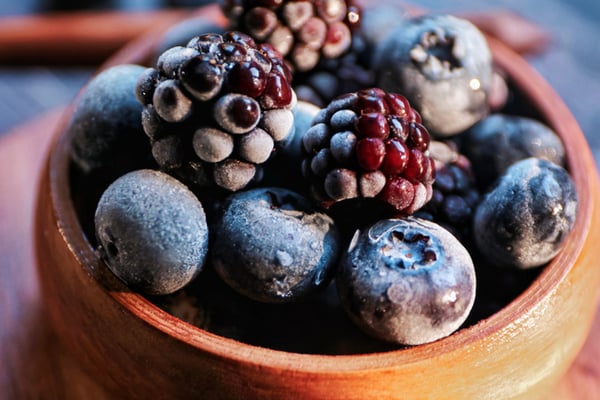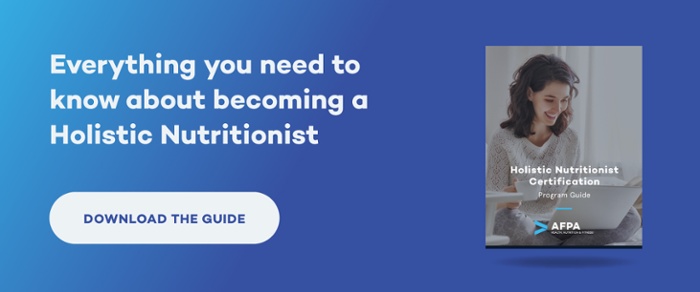You’ve probably heard someone say that you should “eat the rainbow” for optimal nutrition. The idea is to fill your plate with an array of colorful fruits and vegetables that are chock full of vitamins and nutrients.
Blue fruits and vegetables, while less common than their red, yellow, and orange counterparts, should get their own space on your plate. Among other things, they contain powerful antioxidants called anthocyanins that can help boost brain function, improve heart health, and lower your risk of high blood pressure and certain cancers.
Anthocyanins are a type of phytonutrient called flavonoid. Besides their impressive heart and brain benefits, they also fight oxidative stress on the body and slow the effects of aging. There are more than 635 known anthocyanins in existence, and many are found in blue foods. Here are eight of the most common and beneficial blue fruits and vegetables you can add to your diet today.
1. Blueberries
These little blue powerhouses aren’t just delicious — they’re low-calorie, full of fiber, and packed with anthocyanins that will help protect your body against free radicals. Blueberries are also rich with micronutrients like manganese and vitamins C and K.
Some studies have found that blueberries can even protect against urinary tract infections, thanks to their ability to block bacteria from taking up residence in the bladder.
As one of the versatile and convenient fruits for snacking and cooking, blueberries top the list of nutrient-rich blue foods.
2. Concord Grapes
While there may be a bit of debate if concord grapes are purple or blue, they are worthy of the blue fruits and vegetables list for their many antioxidants and immunity-boosting properties. They are one of the most universally popular foods, and for good reason — grapes are delicious on their own or in juices and jams. They also make for great snacks; you can check out our tip for turning grapes into an easy dessert in our recent healthy Halloween swaps article (it’s swap #12).
Even more importantly, studies show that drinking concord grape juice can lead to better brain health, including improvements in memory, cognition, and overall mood.
Keep in mind that grapes are listed on the Environmental Working Group’s Dirty Dozen list of the most pesticide contaminated fruits and vegetables. For this reason, you should prioritize purchasing organic grapes when possible and, as with any produce, ensure that you’re washing them thoroughly before eating to minimize your exposure.
3. Blackberries
These faintly tart berries are rich in fiber and high in vitamin C, vitamin K, and manganese. Vitamin K has been linked to better bone health and improvements in blood clotting properties.
Because of their high fiber and water content, blackberries can help you feel fuller longer and decrease the urge to snack between meals. They are also surprisingly low in carbs, at just 10.2 grams of total carbs per serving (5.3 grams of which are fiber). Because they are so high in nutrients and low in carbs, blackberries are an excellent complement to a variety of different diets.
4. Blue Corn
You may have eaten blue corn tortilla chips at a restaurant and wondered if the corn they came from really is blue. It is, and it’s surprisingly nutritious. Blue corn has been shown to defend against metabolic disorders and to protect against certain cardiovascular issues and cancers. It has even been linked to improvements in HDL cholesterol and lower blood pressure. Keep in mind that over 90% of corn grown in the United States is genetically-modified, so opt for organic and/or non-GMO corn when possible.
5. Elderberries
While not as common as some of its relatives on this list, the elderberry is gaining notoriety as a powerful weapon against colds and the flu. The anthocyanin-rich berries are quite tart on their own, so most people cook them to make an elixir that can help lessen the symptoms of illness and increase the body’s immune response to fight new infections.
Many people make jams or wine with the berries, and they also taste delicious in fresh salads or herbal teas.
6. Black Currants
Despite their name, black currants have a deep, blue-ish purple hue. You can eat them in a variety of ways, including fresh or in teas, jams, or juice. Just one cup of black currants contains more than twice the daily recommended value of vitamin C, making this tiny berry a big ally in protecting against free radicals and chronic diseases.
7. Blue Tomatoes
These unusual tomatoes may not look like their rosy-red counterparts, but they have something important in common. Both contain high amounts of the antioxidant lycopene that has been shown to reduce the risks of prostate cancers, heart disease, stroke, and even cancer.
Like the other blue fruits and vegetables in this list, blue tomatoes have a high anthocyanin content (giving them their unique tint) and may help fight inflammation and stimulate better eye and brain health.
8. Blue Carrots
Did you know that carrots come in a rainbow of colors? Blue carrots, also known as indigo carrots, are full of anthocyanins and praised as a memory-enhancing superfood. Researchers also link blue carrots to improved eyesight and better immune responses.
They are low in calories but high in vitamin C and other vital nutrients. The next time you chop veggies for a salad, throw in a few blue carrots for a colorful twist on an old favorite.
Go Blue
It’s evident that blue fruits and vegetables aren’t just delicious. They have the potential to ward off chronic illness, memory loss, and a whole host of other medical issues. Experiment with blue fruits and vegetables in smoothies, salads, and other recipes to experience the health benefits of these colorful superfoods.





